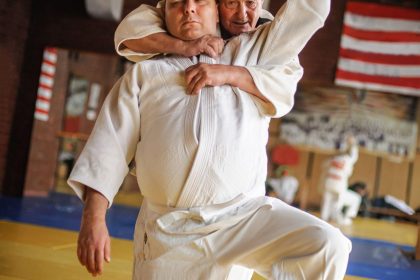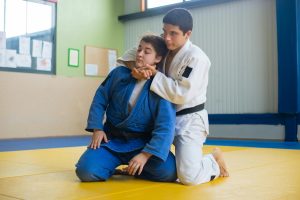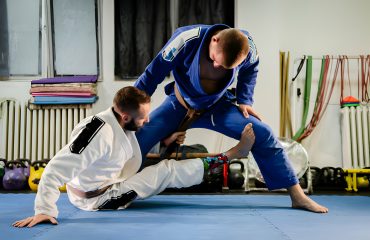
NOCO Jiu-Jitsu: Master Air Choke in BJJ
Brazilian Jiu-Jitsu (BJJ), a martial art celebrated for its emphasis on ground fighting and submission, stands as a testament to the power of technique and strategy over brute force. At the heart of its submission arsenal are air chokes and blood chokes, techniques both feared and revered for their effectiveness in immobilizing opponents. Unlike other grappling arts, BJJ uniquely prioritizes these chokes, making them a cornerstone of its fighting philosophy.
This guide, brought to you by NOCO Jiu-Jitsu and Self-Defense, explores the world of air chokes and blood chokes, examining their critical role in BJJ. Air chokes, which specifically target the opponent’s airway, are distinguished by their ability to force a quick submission by impeding air flow, making them a swift and decisive tool in the hands of a skilled practitioner. Blood chokes, on the other hand, work by applying pressure to the carotid arteries, reducing blood flow and blood supply to the brain, leading to cerebral hypoxia and cerebral ischemia. This causes the opponent to lose consciousness within a few seconds if properly applied.
The purpose of this guide is to provide a comprehensive overview of air chokes and blood chokes within the context of Brazilian Jiu-Jitsu, as taught at NOCO Jiu-Jitsu and Self-Defense. From fundamental techniques cherished by beginners to advanced maneuvers employed by seasoned competitors, this guide aims to illuminate the nuances of these chokes. It serves as an educational resource for practitioners at all levels, offering insights into the mechanics, application, and strategic use of air chokes and blood chokes in both training and competitive environments.
Whether you are just starting your BJJ adventure at NOCO Jiu-Jitsu and Self-Defense or looking to refine your choke techniques, this guide is designed to enhance your understanding and execution of one of BJJ’s most effective and iconic sets of techniques. Techniques such as the rear naked choke, which uses the practitioner’s own arm to apply pressure to the opponent’s neck, and the lateral vascular neck restraint, which compresses the carotid artery, are explored in detail.
The guide also addresses the risks involved with these techniques, including the potential for permanent brain damage due to excessive force or improper application. It emphasizes the importance of proper training and practicing in a controlled environment to ensure the safety of both the practitioner and their training partner.
Additionally, the guide highlights the difference between air chokes and blood chokes in various martial arts and combat sports, including mixed martial arts and Kodokan Judo, where similar techniques are used but with different priorities and applications. The concept of choke hold in self-defense scenarios is also discussed, focusing on their practical use and the importance of understanding the opponent’s neck anatomy to avoid unintentional harm.
Understanding Air Chokes
Definition and Mechanics of Air Chokes

Air chokes in Brazilian Jiu-Jitsu are techniques designed to compress the opponent’s trachea, restricting airflow to the lungs. These chokes work by applying pressure directly to the front of the neck, using either the arms or the legs. The mechanics of an effective air choke involve precise placement of the choking limb and the application of force in a controlled manner. Unlike other submissions, the success of an air choke depends largely on the angle and the point of contact, making it a technique that requires both skill and practice.
In addition to understanding the basic mechanics, practitioners must also be aware of the variations in air chokes. These variations can include the use of different body parts for applying pressure, such as the forearm in a guillotine choke or the legs in a triangle choke. Each variation has its unique setup and execution, which can be adapted to different situations in a match. Learning these variations enhances a grappler’s ability to apply air chokes effectively in various scenarios.
Difference Between Air Chokes and Blood Chokes

Air chokes differ significantly from blood chokes, which are another common type of submission in BJJ. While air chokes target the airway, blood chokes are designed to restrict blood flow to the brain by compressing the carotid arteries on the sides of the neck. Blood chokes tend to be more subtle and can render an opponent unconscious more quickly and with less apparent struggle compared to air chokes.
Understanding the difference between these two types of chokes is crucial for both applying them effectively and for defense. While air chokes often result in a more immediate and noticeable reaction due to the restriction of air, blood chokes can be deceptive as the opponent may not realize the severity of the choke until it’s too late. Practitioners must learn to recognize the symptoms and effects of both types of chokes, not only to apply them effectively but also to ensure the safety of their training partners.
The Importance of Precision and Safety in Air Chokes
Precision in the application of air chokes is vital. Incorrect placement or excessive force can lead to injury, making it essential for practitioners to learn the correct techniques and practice them with care. The safety of both the practitioner and the training partner is paramount in BJJ, and this is especially true for air chokes, which have the potential to cause serious harm if applied recklessly.
Safety in training air chokes extends to understanding when to stop. Practitioners must be attuned to their partner’s reactions and be ready to release the choke immediately upon a tap-out. Regular drilling and sparring under the supervision of experienced instructors can help practitioners develop a sense of control and awareness necessary for safely applying air chokes. This not only prevents injuries but also fosters a respectful and responsible training environment.
Fundamental Air Choke Techniques
Guillotine Choke
Basic Positioning and Grip
– The Guillotine Choke begins with securing a firm grip around the opponent’s neck. The practitioner wraps their arm around the neck, with the hand of the wrapping arm gripping the wrist of the other arm. Proper positioning is essential, as it determines the effectiveness of the choke.
– The grip should be tight and deep, with the forearm pressing against the opponent’s throat. The practitioner’s elbow should be pointed towards their own hip, creating a strong angle for the choke.
Execution and Variations
– To execute the Guillotine Choke, the practitioner needs to arch their back and elevate their hips, applying upward pressure on the opponent’s throat. This movement, combined with the grip, creates a powerful choking force.
– Variations of the Guillotine Choke include the High Elbow Guillotine, where the practitioner’s elbow is raised high to increase pressure, and the Arm-In Guillotine, which includes the opponent’s arm within the choke. Each variation requires slight adjustments in grip and body positioning for maximum effectiveness.
Triangle Choke From Guard
Setting Up the Choke
– The Triangle Choke from guard is initiated by controlling an opponent’s arm and positioning one leg over the opponent’s shoulder, while the other leg wraps around the neck. The key is to create a figure-four lock with the legs.
– Proper setup involves breaking the opponent’s posture and manipulating their arms to create an opening for the legs. This can be achieved through a combination of wrist control and hip movement.
Finishing Details and Common Mistakes
– To finish the Triangle Choke, the practitioner must adjust their angle by shifting their hips and pulling down on the opponent’s head. This increases the pressure of the choke.
– Common mistakes include not securing a tight figure-four lock with the legs or failing to cut an angle, which can reduce the effectiveness of the choke. Practitioners should also avoid crossing their feet, as this can lessen the choking pressure.
Ezekiel Choke
Technique Breakdown
– The Ezekiel Choke is executed by slipping one hand inside the sleeve of the other arm, then wrapping the arms around the opponent’s neck. The fingers of the hand inside the sleeve grip the opposite arm’s bicep, creating a loop around the neck.
– The choke is applied by extending the arms and creating a scissor-like motion, which applies pressure on both sides of the opponent’s neck. Proper hand placement and arm extension are crucial for an effective Ezekiel Choke.
Application in Gi and No-Gi Scenarios
– In Gi scenarios, the Ezekiel Choke is facilitated by the use of the gi sleeve, which provides a grip for the choking hand. The practitioner can use their sleeve or the opponent’s sleeve to execute the choke.
– In No-Gi scenarios, the Ezekiel Choke is modified by using a different grip, such as clasping the hands together or using a gable grip. The principles of the choke remain the same, but the application requires adaptation to the absence of a gi.
Advanced Air Choke Techniques
North-South Choke
Securing the Position
– The North-South choke is initiated from the North-South position, where you are positioned above your opponent’s head. The key is to control their upper body, using your arms to isolate the neck. Proper body alignment is crucial, with your chest pressing down on their chest to limit their mobility.
– To secure the position, slide one arm under your opponent’s neck, ensuring your bicep is close to one side of their neck and your forearm on the other. Your other arm goes around their head, clasping your hands together to secure the grip.
Execution and Adjustments
– To execute the choke, apply downward pressure with your chest while squeezing your arms together. It’s important to keep your weight distributed evenly to maintain control and prevent your opponent from escaping.
– Adjustments may be needed based on your opponent’s reaction. If they try to turn their head or bridge, you may need to shift your weight or adjust your grip. The effectiveness of the choke comes from the combination of arm pressure and body weight, making it a powerful tool in BJJ.
Anaconda Choke
Entry and Grip Details
– The Anaconda choke is typically entered from a front headlock position. You need to snake one arm around the opponent’s neck and under their armpit, securing your hand on the bicep of the other arm. The free hand then grabs the opponent’s shoulder to lock in the position.
– Proper grip is essential for an effective Anaconda choke. Your arm should be tightly coiled around the opponent’s neck, with your grip secured to prevent any gaps. The positioning of your forearm against your neck is crucial for applying the choke.
Finishing the Choke Effectively
– To finish the Anaconda choke, roll to your side, bringing your opponent with you. This movement tightens the choke and limits their ability to defend. Use your legs to trap their body, preventing them from rolling out of the choke.
– As you roll, adjust your grip and squeeze your arms together while applying pressure with your chest. The combination of the roll and the squeeze is what makes the Anaconda choke so effective. It’s a technique that requires practice to master the timing and fluidity of the movement.
Peruvian Necktie
Setup and Positioning
– The Peruvian Necktie starts from a front headlock or similar position. You need to control your opponent’s head and one of their arms. The setup involves placing your leg over the back of the neck while keeping a tight grip on your head and arm.
– Positioning is key for the Peruvian Necktie. Your leg must be placed correctly over the neck, and your hips should be close to your head. This position creates the leverage needed for the choke.
Completing the Choke and Controlling the Opponent
– To complete the choke, fall back while pulling your opponent’s head down with your arms and pushing your leg against their neck. This creates a scissor-like pressure that applies the choke.
– Controlling your opponent during the choke is crucial. Use your free leg to hook their leg or body, preventing them from rolling or escaping. The Peruvian Necktie is a complex but highly effective choke that can be a surprise attack in your BJJ arsenal.
Defense Against Air Chokes
Recognizing and Reacting to Choke Attempts

The first step in defending against air chokes in Brazilian Jiu-Jitsu is to develop an acute awareness of an opponent’s intentions. This skill is honed through experience and keen observation during sparring and training sessions. Recognizing the early signs of a choke attempt, such as an opponent positioning their arms around your neck or adjusting their grip, is crucial. Quick reaction to these attempts can mean the difference between a successful defense and being submitted. Practitioners should focus on disrupting the opponent’s setup, either by changing their position, controlling the attacking arms, or creating space between themselves and the opponent.
In addition to recognizing choke attempts, it’s important to stay calm and avoid panicking. Panic can lead to rushed decisions and movements, making it easier for the opponent to secure the choke. Training to remain composed under pressure is a key aspect of defense. This composure allows for clearer thinking and more effective execution of defensive techniques. Regular drilling of choke defense scenarios can help build this mental resilience.
Defensive Postures and Escape Techniques
Adopting the right defensive posture is essential in preventing an opponent from successfully applying an air choke. One fundamental posture involves tucking the chin and using the hands to protect the neck, creating a barrier against choke attempts. Keeping the neck muscles strong and the head aligned with the spine can also make it more difficult for an opponent to apply a choke.
Escape techniques vary depending on the type of choke being applied. However, common principles include creating space to breathe, breaking the opponent’s grip, and moving out of their control. For example, escaping a guillotine choke often involves pushing the opponent’s elbow upward while turning the head to the side and slipping out. Regular practice of these escape techniques, both in isolation and within the flow of sparring, is crucial for developing effective choke defenses.
Drills for Improving Choke Defense
Drills are an effective way to improve defense against air chokes. These drills should simulate realistic scenarios where one partner attempts various choke techniques while the other practices defending against them. Starting in different positions, such as standing, guard, or side control, can provide a comprehensive defense training experience.
One useful drill involves the defender starting in a disadvantaged position, such as with the opponent having a partial choke already set up. The defender then works to escape using the appropriate techniques. This drill not only improves technical skills but also builds confidence in the ability to escape from difficult situations. Another beneficial drill is the flow roll, where partners continuously switch between attacking and defending, allowing for the practice of choke defense in a dynamic and fluid context. These drills, when practiced consistently, can significantly enhance a practitioner’s ability to defend against air chokes in Brazilian Jiu-Jitsu.
Training and Drilling Air Chokes
Safe Practice and Injury Prevention

In the world of Brazilian Jiu-Jitsu, the safety of practitioners is paramount, especially when training in techniques like air chokes. At NOCO Jiu-Jitsu and Self-Defense, we emphasize the importance of understanding the mechanics of air chokes to apply them safely and effectively. Practitioners are taught to recognize the signs of excessive pressure and to respect the tap-out signal immediately. This respect for safety extends to being aware of one’s limits and the limits of training partners. Regular seminars on safe training practices are conducted to ensure that all members are well-versed in the safe application of air chokes.
Additionally, injury prevention is a key focus. This involves proper warm-up exercises to prepare the neck and throat muscles for training. Stretching and strengthening exercises are integrated into classes to reduce the risk of strain or injury. Practitioners are also educated on the correct way to apply and release chokes to prevent abrupt movements that could lead to injury. This careful approach to training air chokes ensures that practitioners can learn and apply these techniques confidently and safely.
Solo and Partner Drills for Air Chokes
Solo drills are an essential part of training at NOCO Jiu-Jitsu and Self-Defense, especially for refining the movements and mechanics of air chokes. These drills include exercises that improve grip strength, precision in hand placement, and the fluidity of motion required for effective choke application. Practitioners often use training dummies to practice the positioning and execution of various air chokes, allowing them to develop muscle memory for these techniques.
Partner drills, on the other hand, are crucial for understanding the application of air chokes in a more realistic context. These drills involve working with a partner to practice the setup, execution, and transitions between different air chokes. Safety and communication are heavily emphasized during these drills, with partners providing feedback to each other on the application’s effectiveness and comfort. This collaborative approach not only enhances skill development but also fosters a supportive training environment.
Incorporating Air Chokes Into Sparring and Competition
Sparring sessions at NOCO Jiu-Jitsu and Self-Defense provide an excellent opportunity for practitioners to test and refine their air choke techniques in a dynamic and resistant environment. In these sessions, students are encouraged to experiment with different setups and entries for air chokes, learning how to adapt their techniques against an actively resisting opponent. This experience is invaluable for understanding the practical application of air chokes in a real grappling scenario.
When preparing for competition, special focus is given to the strategic use of air chokes. Competitors are trained to recognize opportunities for air chokes during matches and to use them effectively to gain an advantage or secure a submission. Coaches at NOCO Jiu-Jitsu and Self-Defense also work with students to develop game plans that incorporate air chokes, tailored to their styles and strengths. This comprehensive approach to training ensures that practitioners are well-equipped to use air chokes effectively, whether in the gym or on the competition mat.
Air Chokes in BJJ Competitions
Legal Considerations and Rules
In BJJ competitions, understanding the legalities and rules surrounding air chokes is crucial. Different organizations may have varying regulations on what is permissible, especially concerning the safety of choke techniques. For instance, some competitions may restrict certain air chokes for lower belt levels due to the risk of injury. It’s essential for competitors to be well-versed in these rules to avoid disqualifications and to strategize effectively. Additionally, referees in BJJ tournaments are trained to closely monitor choke submissions for signs of distress or unconsciousness in competitors, ensuring the safety of all participants.
Moreover, the rules regarding air chokes can influence a competitor’s training and preparation. Knowing which chokes are allowed at different competition levels can guide practitioners in focusing their training on specific techniques. This targeted training approach can be beneficial in developing a competitive edge, as competitors can refine and master the air chokes that are most effective within the rule set of their target tournaments.
Strategies for Effectively Using Air Chokes in Matches
Incorporating air chokes into a competition strategy requires both technical proficiency and tactical awareness. Successful competitors often use air chokes not only as a means to secure a submission but also as a way to control the pace of the match and dictate their opponent’s movements. For example, a well-executed guillotine choke attempt can force an opponent to defend in a certain way, opening up opportunities for transitions or other submissions.
Additionally, setting up air chokes can be a strategic way to conserve energy during a match. Unlike some techniques that require significant physical exertion, air chokes can be applied efficiently with minimal energy expenditure when executed correctly. This efficiency allows competitors to maintain a high level of performance throughout the match. It’s also important for competitors to be adaptable, as opponents may be well-prepared to defend against common air chokes. Developing a diverse set of air choke techniques and being able to switch between them fluidly can be a key factor in outmaneuvering opponents in competition.
Notable BJJ Practitioners and Their Use of Air Chokes
Many renowned BJJ practitioners have gained fame for their exceptional use of air chokes in competition. These athletes have demonstrated the effectiveness of air chokes at the highest levels of the sport, often securing victories against formidable opponents. For example, Marcelo Garcia, known for his innovative and aggressive style, has effectively used the guillotine choke in numerous competitions, making it one of his signature moves. His ability to apply the choke from various positions has made him a feared competitor in the BJJ community.
Another notable practitioner is Roger Gracie, who has used the cross-collar choke from the mount position to dominate in world-class competitions. His precise technique and timing in applying this choke have led to many victories, showcasing the power of air chokes when used by a skilled practitioner. These athletes, among others, serve as inspirations for BJJ students and competitors worldwide, proving that mastering air chokes can be a key to success in Brazilian Jiu-Jitsu competitions.
The Role of Air Chokes in a Well-rounded BJJ Game
Air chokes hold a place of high esteem in the arsenal of Brazilian Jiu-Jitsu techniques, especially at NOCO Jiu-Jitsu and Self-Defense. Their ability to swiftly subdue an opponent by targeting the airway makes them an indispensable tool for any practitioner striving to develop a well-rounded BJJ game. The mastery of air chokes not only enhances a grappler’s offensive capabilities but also deepens their understanding of defense and control in various grappling scenarios. As a fundamental aspect of BJJ strategy, air chokes encourage practitioners to think critically, act swiftly, and apply techniques with precision.
The path to mastering air chokes in BJJ is continuous and demands dedication, practice, and a commitment to learning. At NOCO Jiu-Jitsu and Self-Defense, we encourage practitioners of all levels to persistently explore and refine their air choke techniques. This ongoing process of learning and improvement is not just about acquiring new skills; it’s about adopting the evolving nature of BJJ and the endless possibilities it offers. Regular practice, coupled with a willingness to learn and adapt, is key to mastering the art of air chokes and excelling in Brazilian Jiu-Jitsu.
In conclusion, mastering air chokes in Brazilian Jiu-Jitsu is a rewarding endeavor that contributes significantly to a practitioner’s growth and success in the sport. These techniques, emblematic of the strategic depth and technical sophistication of BJJ, offer a clear path to gaining an upper hand in both training and competitive environments. At NOCO Jiu-Jitsu and Self-Defense, we believe in the power of air chokes to not only secure victories but also to foster a deeper appreciation for the art of Brazilian Jiu-Jitsu. As practitioners continue to train and evolve, the mastery of air chokes remains a shining example of the effectiveness and elegance inherent in BJJ. Contact us for more details!
FAQ: Air Chokes and Blood Chokes in Brazilian Jiu-Jitsu (BJJ)
How do air chokes work in Brazilian Jiu-Jitsu?
Air chokes work by compressing the opponent's trachea or upper airway, impeding air passage and airflow. Proper training is essential to ensure these chokes are applied correctly and safely.
What are the risks involved with air chokes and blood chokes?
Risks include permanent brain damage due to cerebral hypoxia (lack of enough oxygen) or cerebral ischemia (restricted blood flow). Excessive force can also cause injury to the opponent's neck or other critical structures.
How does the rear naked choke apply pressure?
The rear naked choke uses the practitioner's own arm to apply pressure to the opponent's neck, specifically targeting the carotid arteries, which restricts blood flow to the brain and induces unconsciousness.
Why is proper training important for applying chokes in martial arts?
Proper training ensures chokes are applied safely and effectively, preventing injuries and teaching practitioners to recognize when to release the choke to avoid causing harm.
What should practitioners be aware of when applying a lateral vascular neck restraint?
Practitioners should apply pressure correctly to target the carotid arteries without causing damage to the trachea or other neck structures. Understanding the anatomy of the opponent's neck is crucial.
How can choke holds be used in self-defense?
Choke holds can quickly incapacitate an attacker by restricting their airflow or blood flow. In self-defense scenarios, they must be used judiciously and with an understanding of the risks involved.
What are some common mistakes when applying a tracheal choke?
Common mistakes include improper placement of the choking limb, applying excessive force, or failing to secure a tight grip. These errors can lead to ineffective chokes or injuries to both the practitioner and the opponent.
How do martial artists train to defend against air chokes and blood chokes?
Training involves recognizing choke attempts, adopting defensive postures, and practicing escape techniques. Drills in a controlled environment help practitioners improve their response and defense strategies.
How do blood chokes affect blood circulation and blood supply to the brain?
Blood chokes compress the carotid arteries, reducing blood circulation and blood supply to the brain. This can cause the opponent to lose consciousness within seconds if the choke is applied correctly.



